|
Performance Awards
Performance Awards Home
Nomination Criteria and Tips
Make a nomination
Contact us via email
Recipients
2014 |
2013 |
2012 |
2011 |
2010 |
2009 |
2008 |
2007 |
2006 |
2005 |
2004 |
1999 - 2003
|
CIRES Outstanding Performance Awards >
Recipients Recognized in 2010
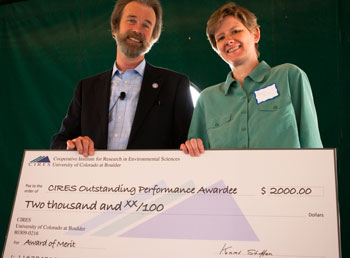 Alysha Reinard, Science and Engineering Award Alysha Reinard, Science and Engineering Award
Alysha Reinard is a CIRES Research Associate with the Space Weather Prediction Center (SWPC). She was nominated for CIRES Outstanding Performance Award in Science and Engineering for ground-breaking scientific research that results in a major improvement to predict the time, strength, and location of solar flares. Solar flares are the most energetic explosions in the solar system, releasing abundant radiation, mostly in the form of X-rays and ultraviolet emissions, but also in the form of proton radiation. These powerful blasts of energy affect the Earth’s upper atmosphere and ionosphere, which in return can disturb many technological systems, like GPS navigation or radio communications for instance. Because of their societal and economic impacts, predicting solar flares is one of the most important scientific problems as well as one of the major challenges for space weather forecasting. For many years, many scientists have worked on predicting solar flares with inconclusive results. But thanks to the outstanding contribution of Dr. Reinard, a new technique for predicting solar flares was developed. To achieve her results, she examined solar observations made by the National Science Foundation’s Global Oscillation Network Group (GONG) and found a relation between the amount and rate of twist in the magnetic fields beneath the surface of the sun, and the subsequent eruption of a flare. With this technique, it is now possible to issue one to several day warning of when and where a flare will occur and how strong it will be, and this with unprecedented accuracy.
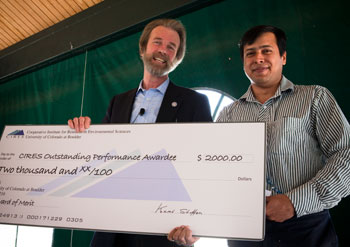 Manoj Nair, Science and Engineering Award Manoj Nair, Science and Engineering Award
Over the past two years, Manoj Nair has contributed significant research results to the field of equatorial ionospheric electrodynamics. Through careful analysis of large data sets, Manoj derived an accurate characterization of the complicated phenomenon of “prompt penetration”, which plays a key role in the interaction between the solar wind and the equatorial ionosphere. It has long been observed that the Interplanetary Electric Field (IEF) in the solar wind shows a remarkable correlation with the Eastward Electric Field (EEF) in the equatorial ionosphere. From direct comparisons of events, it seemed that about 10% of the IEF penetrated to the equatorial ionosphere. Manoj recognized that this popular “10%-rule” could be characterized much more accurately by employing advanced signal processing methods, with which he was familiar from his previous work in magneto-telluric subsurface exploration. Using 8 years of solar wind, radar and satellite measurements, Manoj derived an empirical prompt penetration model which allows scientists to predict electric field variations in the equatorial ionosphere from solar wind observations. This widely recognized work has significantly improved our understanding of prompt penetration and directly benefits electrodynamic models of the equatorial ionosphere.
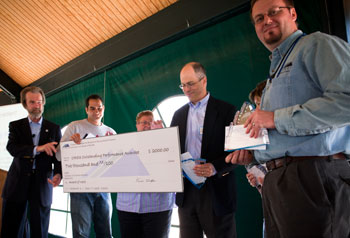 Paul Lotoaniu, Josh Rigler, Juan Rodriguez, Leslie Mayer and Mary Shouldis (GOES-R team), Science and Engineering Award Paul Lotoaniu, Josh Rigler, Juan Rodriguez, Leslie Mayer and Mary Shouldis (GOES-R team), Science and Engineering Award
Paul Lotoaniu, Josh Rigler, Juan Rodriguez, Leslie Mayer and Mary Shouldis are members of the CIRES Space Weather GOES-R Product Development Team and are nominated for CIRES Outstanding Performance Award in Science and Engineering for successful delivery of the Phase One Space Weather algorithms for R-series Geostationary Operational Environmental Satellite (GOES-R). The purpose of these algorithms is to process raw space weather observations into data used to specify, analyze and forecast the space environmental conditions. To achieve their goals, the team members determined the product requirements and conducted the necessary research to define and produce the best algorithms. They followed the National Environmental Satellite, Data and Information Service (NESDIS) coding standards to produce pseudo-operational codes. Then they ensured their algorithms were functioning properly and accurately, and validated them against known standards. Finally, they proficiently documented the algorithms before delivering them to NESDIS. The team developed six major algorithms that fulfilled twenty-two top-level product requirements. They used cutting edge scientific procedures and technologies to produce better products in a more efficient manner. The products will provide NOAA’s Space Weather Prediction Center with data and tools to support its customers ranging from NASA and the U.S. Air Force to power companies and commercial airlines.
As a result of their exceptional commitment to this mission, NESDIS management praised the work done by this team as the best presentations and highest quality product deliverables of any of the more than thirty teams making up the GOES-R program. Moreover, the team members quickly became the experts that operations, management and other researchers go to for information on the GOES instruments, data and products.
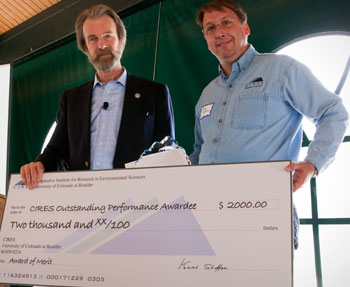 Steven Peckham, Service Awards Steven Peckham, Service Awards
Steven Peckham of GSD helped develop and provide support to a complex modeling system known as WRF-Chem. This system allows research of extreme relevance to current environmental challenges, especially relating to air quality and global climate change. This model has lead to many national and international publications as well. WRF-Chem has over 1,000 users and due to a large amount of help requests, Steve selflessly volunteered to take care of the help requests which totaled up to 700 this past year (not including the community model). He has also led tutorials in Boulder, Korea and Mexico City educating people on this state-of-the-art system which were praised. The World Meteorological Organization Global Atmospheric Watch (GAW) Urban Research Meteorology and Environment Project (GURME) used the WRF-Chem model in workshops in San Paola, Brazil, Mexico City, Mexico and Prune, India. Steve provided hands-on training at these workshops and worked hard to ensure language barriers and differing computing backgrounds were worked through. As a result, the training has made an impact on these regions conducting air quality studies. Without Steve’s help, users of this system would spend hours trying to figure out problems and as a result of his effort, the model now has many national and international users. Not only does he represent WRF-Chem, but also CIRES. Having a CIRES employee give so much effort and dedication to their job shows the environmental science community outstanding CIRES values. Steve is an employee helping to ensure the CIRES reputation for excellence is upheld.
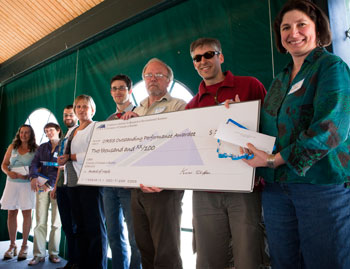 MaryJo Brodzik, Brendan Billingsley, Julia Collins, Doug Fowler, Jonathan Kovarik, Donna Scott, Barbara O'Barr, Stephen Truex, Bruce Raup, Deann Miller (SEARCHLIGHT team), Service Award MaryJo Brodzik, Brendan Billingsley, Julia Collins, Doug Fowler, Jonathan Kovarik, Donna Scott, Barbara O'Barr, Stephen Truex, Bruce Raup, Deann Miller (SEARCHLIGHT team), Service Award
Organizing the large quantities of data that CIRES scientists acquire is not a trivial task - and making that data intuitively searchable is even less so. However, the Searchlight team (MaryJo Brodzik, Brendan Billingsley, Julia Collins, Doug Fowler, Jonathan Kovarik, Donna Scott, Barbara O'Barr, Stephen Truex, Bruce Raup, Deann Miller) employed an uncommon focus of teamwork, technical innovation and simple hard work to create a new online interface and data system infrastructure for cryospheric data at the National Snow and Ice Data Center (NSIDC). This interface not only will improve the efficiency of research at CIRES, but will allow researchers around the world to access and interact with NSIDC data, ranging from sea ice concentration to albedo. The team broke new ground in working together in a unique way using the "Agile software development approach". While Agile development is nothing new to software engineering, it is absolutely new to NSIDC, and was initially thought to be too risky to try. Despite management's initial skepticism, the team's passion and enthusiasm swayed them to allow the experiment. The team worked effectively and efficiently together and with frequent input from stakeholders to develop a cutting edge, searchable data infrastructure scheme. The Searchlight team is exemplary of what puts CIRES at the forefront of environmental research: a passion for trying new approaches, an ability to constructively interact in a team, and an enthusiasm for making cutting edge data accessible for research both within and outside of CIRES. |